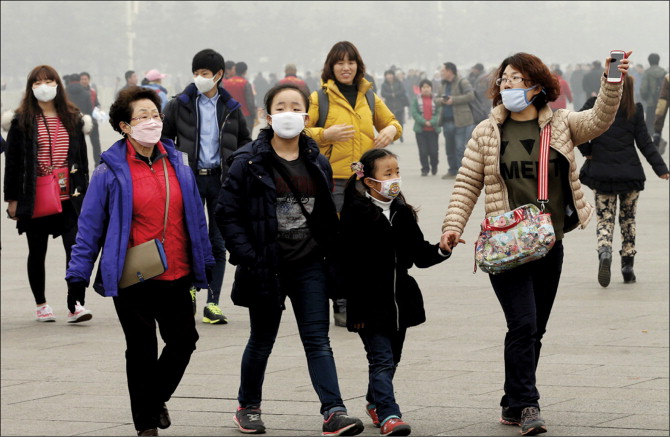The impact of air pollution on human health is a significant factor, with estimates suggesting it contributes to nearly 20% of all deaths.
In this article, we will explore 10 effects of air pollution on Human Health.
Air pollution poses the greatest risk to environmental health, affecting humans, animals, and plants.
It comprises harmful chemicals or particles present in the air, causing detrimental effects on health and even damaging structures.
Sources of Air Pollution
Air pollution enters the Earth’s atmosphere through various means. The majority of air pollution is a result of human activities, including emissions from factories, vehicles, airplanes, and aerosol cans.
Second-hand cigarette smoke is also recognized as a form of air pollution. These human-induced sources of pollution are referred to as anthropogenic sources.
The main causes of air pollution include emissions from various modes of transportation, the combustion of fossil fuels, industrial production, forest fires, the use of aerosols, and radiation.
- Industrial Emissions: Industries and factories release various pollutants into the air, including particulate matter, sulfur dioxide (SO2), nitrogen oxides (NOx), volatile organic compounds (VOCs), and hazardous air pollutants (HAPs).
- Vehicle Emissions: Transportation, especially vehicles running on fossil fuels, is a significant contributor to air pollution.
Exhaust emissions from cars, trucks, buses, and motorcycles release pollutants like carbon monoxide (CO), nitrogen oxides (NOx), particulate matter (PM), and volatile organic compounds (VOCs).
- Power Generation: Power plants that burn fossil fuels, such as coal, oil, and natural gas, emit pollutants into the air. These emissions include sulfur dioxide (SO2), nitrogen oxides (NOx), particulate matter (PM), and greenhouse gasses like carbon dioxide (CO2) and methane (CH4).
- Residential and Commercial Sources: Everyday activities in homes and commercial buildings can contribute to air pollution.
These sources include burning fossil fuels for heating and cooking, using certain consumer products that release VOCs, and inadequate ventilation leading to indoor air pollution.
WHO issued a set of normative guidance, the Guidelines for indoor air quality: household fuel combustion. This offers practical evidence-based guidance on what fuels and technologies used in the home can be considered clean, including recommendations.
- Agricultural Activities: Agricultural practices, such as burning crop residues, livestock farming, and the use of fertilizers and pesticides, can release pollutants into the air. These activities generate pollutants like ammonia (NH3), methane (CH4), and particulate matter (PM).
- Natural Sources: Natural sources of air pollution include dust and smoke from wildfires, volcanic eruptions, and windblown dust from deserts. While these sources are not under human control, they can significantly impact air quality, especially in certain regions.
The extent and impact of air pollution can vary depending on geographical location, industrial activities, population density, and environmental regulations in place.
The World Health Organization (WHO) works on Air Pollution and also works on Public Health, Environmental and Social Determinants of Health.
The organization identifies and monitors air pollutants that have a significant impact on people’s health.
With thorough analysis and reviews they seek scientific evidence related to air pollution and expert advice, to conclude the extent to which different air pollutants affect health.
The organization also aims to identify effective measures to reduce the burden of air pollution.
In recognition of the detrimental health effects caused by air pollution, in 2015 – WHO Member States adopted a resolution.
This resolution establishes a roadmap for an improved global response to address these adverse health effects of air pollution. The roadmap focuses on four key areas:
- Expanding the knowledge base: Enhancing understanding and knowledge related to air pollution and its impact on health.
- Monitoring and reporting: Implementing systems to monitor air pollution levels and regularly report on them.
- Global leadership and coordination: Promoting leadership and cooperation at the global level to effectively combat air pollution.
- Institutional capacity strengthening: Strengthening the capacity of institutions to address air pollution and its health consequences.
Who is more vulnerable to health issues – Air Pollution?
Children and teenagers are especially susceptible as their bodies, organs, and immune systems are still in the developmental stage.
Air pollution negatively impacts their health during childhood and raises the likelihood of future diseases. However, children have limited ability to safeguard themselves or influence policies concerning air quality.
The List of Effects of Air Pollution on Human Health
Exposure to air pollution can have a wide range of health effects on individuals. These effects can be categorized into short-term and long-term impacts.
Short-term effects are temporary and encompass illnesses like pneumonia and bronchitis.
They also involve discomfort such as irritation of the nose, throat, eyes, or skin. Headaches, dizziness, and nausea can also be caused by air pollution.
Additionally, unpleasant odors emitted by factories, garbage, or sewer systems are considered a form of air pollution, though they are less severe.
On the other hand, the long-term effects of air pollution can persist for many years or even a lifetime, and they can be life-threatening.
Here are 10 Effects of Air Pollution on Human Health:
Air pollution and respiratory issues:
Air pollution can cause or worsen respiratory conditions such as asthma, bronchitis, and chronic obstructive pulmonary disease (COPD).
Inhalation of polluted air can irritate the airways, leading to breathing difficulties and an increased risk of respiratory infections.
Cardiovascular Problems:
Exposure to air pollution has been linked to an increased risk of cardiovascular diseases, including heart attacks, strokes, and high blood pressure.
Fine particles and pollutants can enter the bloodstream and cause inflammation, damage to blood vessels, and clotting.
Air Pollution and Lung Cancer:
Prolonged exposure to certain air pollutants, such as particulate matter and carcinogenic substances like benzene and formaldehyde, can increase the risk of developing lung cancer.
The specialized cancer agency of the World Health Organization, the International Agency for Research on Cancer (IARC), announced that it has classified outdoor air pollution as a leading cause of cancer.
Allergies and Allergic Reactions:
Air pollution can trigger allergic reactions and worsen existing allergies. Pollen, dust mites, and other airborne allergens can interact with pollutants, exacerbating symptoms like sneezing, itching, and congestion.
Impaired Lung Development in Children:
Children exposed to air pollution may experience impaired lung development, leading to long-term respiratory issues and reduced lung function throughout their lives.
Premature Death:
The adverse health effects of air pollution can lead to premature death, particularly in individuals with pre-existing health conditions.
High levels of pollutants, such as fine particulate matter, have been associated with increased mortality rates.
Neurological Effects:
Some studies suggest that air pollution, particularly fine particulate matter, may have detrimental effects on the central nervous system, potentially contributing to cognitive decline, neurodevelopmental disorders, and an increased risk of neurodegenerative diseases.
Respiratory Infections:
Air pollution weakens the respiratory system’s defenses, making individuals more susceptible to respiratory infections such as pneumonia, bronchitis, and influenza.
Increased Risk of Asthma Attacks:
Air pollution can trigger asthma attacks in individuals with the condition, leading to symptoms such as wheezing, coughing, chest tightness, and shortness of breath.
Adverse Pregnancy Outcomes:
Pregnant women exposed to air pollution face an increased risk of complications, including preterm birth, low birth weight, and developmental issues in newborns. Pollutants can cross the placental barrier and affect fetal growth and development.
Regulation / Control of Air Pollution
Governments and organizations implement measures to mitigate the harmful impacts of air pollutants on human health and the environment.
Many advanced countries have implemented legislation to control emissions and mitigate air pollution.
Here are Regulatory and Control Measures for Air Pollution:
- Environmental Standards and Regulations: Governments set specific air quality standards and regulations to limit pollutant emissions from various sources.
These standards define acceptable pollutant levels and establish guidelines to reduce emissions and maintain air quality within safe limits.
- Emission Controls: Industries and vehicles are subject to emission control measures to reduce their pollution outputs.
This includes the installation of pollution control technologies, such as filters and scrubbers, to trap and remove pollutants before they are released into the air.
Vehicle emission standards, such as catalytic converters and emission testing programs, are also enforced to limit vehicle pollution.
- Renewable Energy Promotion: Governments and organizations encourage the adoption of renewable energy sources, such as solar, wind, and hydroelectric power, as an alternative to fossil fuels.
- Air Quality Monitoring: Regular monitoring of air quality is crucial for identifying pollution hotspots and assessing the effectiveness of control measures.
- Environmental Impact Assessments: Major industrial and infrastructure projects undergo environmental impact assessments to evaluate their potential air pollution impacts.
These assessments help in identifying and implementing appropriate mitigation measures to minimize or offset the environmental consequences of these projects.
- International Cooperation and Agreements: International cooperation plays a significant role in addressing air pollution issues, especially those that transcend national boundaries.
Collaborative efforts, such as the United Nations Framework Convention on Climate Change (UNFCCC) and The WHO facilitate the sharing of knowledge, best practices, and joint actions to combat air pollution globally.
Conclusion
Air pollution poses significant risks to human health. It can cause respiratory problems, cardiovascular diseases, allergies, and increase the risk of lung cancer. Long-term exposure to polluted air can have detrimental effects on overall health and life expectancy.
Children are particularly vulnerable to the health impacts of air pollution due to their developing respiratory systems. Air pollution has also been associated with an increased risk of cardiovascular diseases such as heart attacks and strokes.
It is important to note that the specific health effects of air pollution may vary depending on the type and concentration of pollutants, individual susceptibility, and duration of exposure. Implementing measures to reduce air pollution and promoting clean air initiatives are crucial for safeguarding human health.


